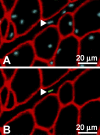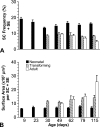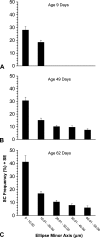Pax7 reveals a greater frequency and concentration of satellite cells at the ends of growing skeletal muscle fibers
- PMID: 17938281
- PMCID: PMC2323121
- DOI: 10.1369/jhc.7A7301.2007
Pax7 reveals a greater frequency and concentration of satellite cells at the ends of growing skeletal muscle fibers
Abstract
The main sites of longitudinal growth in skeletal muscle are the ends of the fibers. This study tests the hypothesis that satellite cells (SCs) are at a greater frequency (#SC nuclei/all nuclei within basal laminae) and concentration (closer together) within growing fiber ends of posthatch chicken pectoralis. SCs were localized by their Pax7 expression, and fiber ends were identified by their retention of neonatal myosin heavy chains and small cross-sectional profiles. Whereas SC frequency decreased from about 20% at 9 days posthatch to <5% at 115 days, fiber ends retained a frequency of approximately 16%. Calculated mean area of sarcolemma per SC revealed higher concentrations of SCs at fiber ends. There was also a strong inverse correlation between SC frequency and fiber profile cross-sectional size throughout development. This study suggests that SCs at fiber ends play a key role in the longitudinal growth of muscle fibers, and that fiber profile size may impact SC distribution.
Figures





References
-
- Allen DL, Roy RR, Edgerton VR (1999) Myonuclear domains in muscle adaptation and disease. Muscle Nerve 22:1350–1360 - PubMed
-
- Bandman E (1985) Continued expression of neonatal myosin heavy chain in adult dystrophic skeletal muscle. Science 227:780–782 - PubMed
-
- Bandman E, Rosser BWC (2000) Evolutionary significance of myosin heavy chain heterogeneity in birds. Microsc Res Tech 50:473–491 - PubMed
Publication types
MeSH terms
Substances
Grants and funding
LinkOut - more resources
Full Text Sources

